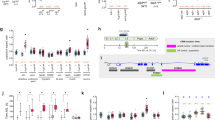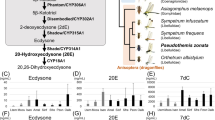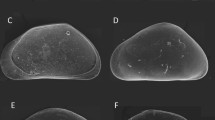Abstract
INSECTS are the only group of arthropods in which the control of moulting is well understood. A group of steroids—the ecdysones, thought to be produced by the prothoracic or ecdysial glands—cause moulting in almost all insect groups in which they have been tested1. Ecdysones isolated from a crustacean2 and from several different plants3 were active in insects4,5. No reports exist of moulting induced by ecdysones in arthropods other than insects, but ecdysterone shortened the period between moults in crayfish which had been induced to moult by removal of their eyestalks6.
This is a preview of subscription content, access via your institution
Access options
Subscribe to this journal
Receive 51 print issues and online access
$199.00 per year
only $3.90 per issue
Buy this article
- Purchase on SpringerLink
- Instant access to full article PDF
Prices may be subject to local taxes which are calculated during checkout
Similar content being viewed by others
References
Novak, V. J. A., Insect Hormones, 78 (Methuen, London, 1966).
Karlson, P., Zool. Anz. Suppl., 20, 203 (1957). Hampshire, F., and Horn, D. H. S., Chem. Commun., 2, 37 (1966).
Imai, S., Fujioka, S., Nakanishi, K., Koreda, M., and Kurokawa, T., Steroids, 10, 557 (1967).
Kobayashi, M., Takemoto, T., Ogawa, S., and Nishimoto, N., J. Insect Physiol., 13, 1395 (1967).
Williams, C. M., Biol. Bull., 134, 334 (1968).
Lowe, M. F., Horn, D. H. S., and Galbraith, M. N., Experientia, 24, 518 (1968).
Hocks, P., Schulz, G., and Karlson, P., Naturwissenschaften, 54, 44 (1967).
Kaplanis, J. N., Thompson, M. J., Robbins, W. E., and Bryce, B. M., Science, 157, 1436 (1967). Staal, G. B., Proc. Nederl. Akad. Wetenschappen, Amsterdam, Ser. C., 70, 409 (1967).
Sato, Y., Sakai, M., Imai, S., and Fujioka, S., Appl. Entomol. Zool. (Japan) (in the press).
Hagstrum, D. W., Ann. Entomol. Soc. Amer., 61, 591 (1968).
Author information
Authors and Affiliations
Rights and permissions
About this article
Cite this article
KRISHNAKUMARAN, A., SCHNEIDERMAN, H. Chemical Control of Moulting in Arthropods. Nature 220, 601–603 (1968). https://doi.org/10.1038/220601a0
Received:
Issue date:
DOI: https://doi.org/10.1038/220601a0
This article is cited by
-
Partial molting synchrony in the giant Malaysian prawn,Macrobrachium rosenbergii: A chemical communication hypothesis
Journal of Chemical Ecology (1981)
-
Experimental evidence of the molt controlling function of the Y-organ of a macruran decapod,Orconectes limosus
Journal of Comparative Physiology ? B (1976)
-
Crustecdysone is without estrogenic or antiestrogenic activity in the rat
Experientia (1974)
-
Molting hormone content, cuticle growth and gastrolith growth in the molt cycle of the crayfishOrconectes limosus
Journal of Comparative Physiology (1973)
-
Comparison of the abilities of ?-ecdysone and 20-hydroxyecdysone to induce precocious proecdysis and ecdysis in the fiddler crab, Uca pugilator
Zeitschrift f�r Vergleichende Physiologie (1972)



